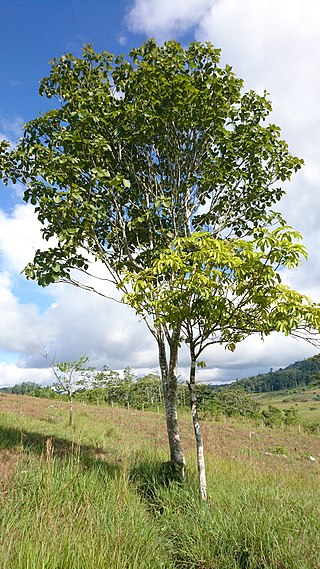
Juniperus standleyi is a species of juniper native to Guatemala and the adjacent extreme southeast of Mexico, where it occurs at elevations of 3,000–4,250 metres. Its local common names include huitó, cipres, and huitum.

Pinus pseudostrobus, known in English as the smooth-bark Mexican pine and in Spanish as chamite or pacingo, is a tree found in forests of Mexico and Central America. It is 8 to 25 m tall with a dense and round top.It is threatened by logging and wood harvesting. The bark is brown and fissured and smooth when young. It is subject to ex-situ conservation. It grows at altitudes between 850 and 3250 m. from 26° to 15° north latitude, from Sinaloa, Mexico to Nicaragua and Honduras. It occurs within a rainfall regime that rains mostly in summer.
Marlothiella gummifera is a species of flowering plant in the family Apiaceae, and the only species in the monotypic genus Marlothiella. It is endemic to Namibia, where its natural habitats are rocky areas and cold desert. It is also the only genus in the tribe Marlothielleae, of the subfamily Apioideae.
Amolops kaulbacki is a species of frog in the family Ranidae that is found in northern Myanmar and Mizoram in northeastern India. It is named after Ronald Kaulback, a British botanist and explorer who collected the type series. Very little is known about this species.
Axinaea sodiroi is a species of plant in the family Melastomataceae. It is endemic to Ecuador. Its natural habitat is subtropical or tropical moist montane forests.

Helicia is a genus of 110 species of trees and shrubs, constituting part of the plant family Proteaceae. They grow naturally in rainforests throughout tropical South and Southeast Asia, including India, Sri Lanka, Indochina, Peninsular Malaysia to New Guinea and as far south as New South Wales.

Hoodia juttae is a species of plant in the family Apocynaceae. It is endemic to Namibia. Its natural habitats are rocky areas and cold desert. H. juttae is found around the Little and Great Karas mountains. It is threatened by collection. The plant was discovered by Jutta Dinter, the wife of botanist, Kurt Dinter in 1913. The scientific name refers to Jutta.
Ledebouria grandifolia is a species of flowering plant in the Asparagaceae family. It is endemic to Yemen. Its natural habitats are subtropical or tropical dry forests and rocky areas.
Marcgraviastrum sodiroi is a species of plant in the Marcgraviaceae family endemic to Colombia and Ecuador.
Palicourea sodiroi is a species of plant in the family Rubiaceae. It is a shrub and grows primarily in wet tropical habitats. It is endemic to Ecuador.
Piper sodiroi is a species of plant in the family Piperaceae. It is endemic to Ecuador.
Sessea sodiroi is a species of plant in the family Solanaceae, it can grow up to tree-size. It is endemic to Ecuador.

Simira is a genus of plants in the family Rubiaceae. The genus was first published by French pharmacist and botanist Jean Baptiste Christophore Fusée Aublet in Hist. Pl. Guiane vol.1 on page 170 in 1775.
Simira wurdackii is a species of plant in the family Rubiaceae. It is endemic to Peru.

Zamia standleyi is a species of plant in the family Zamiaceae. It is endemic to Honduras, and is threatened by habitat loss.

Paul Carpenter Standley was an American botanist known for his work on neotropical plants.

John Thomas Howell was an American botanist and taxonomist. He became an expert of Eriogonum (buckwheat) species, which are widely represented in the native California flora.

Carnarvonia araliifolia, commonly known as the red oak, red silky oak, Caledonian oak or elephant's foot, is the sole species in the monotypic genus Carnarvonia, a member of the Proteaceae plant family. It is endemic to the rainforests of northeastern Queensland.
Gereaua is a monotypic genus of flowering plants belonging to the family Sapindaceae. It only contains one species, Gereaua perrieri.
Cyperus multifolius is a species of sedge that is native to Central America and northern South America.









